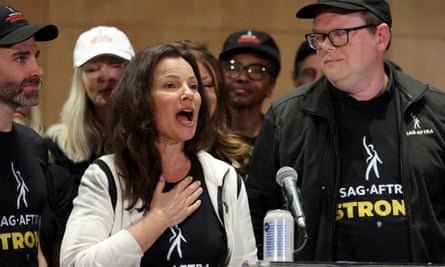
Margot Robbie’s global tour of Barbie outfits didn’t reach New York. A screening of Mattel’s doll-inspired would-be mega-franchise stood in place of a premiere. With the actors on strike, it was a stiff in PR terms, but one that went unnoticed amid the year-long, $100m (£80m), all-pink marketing drive leading up to the film’s $155m US opening weekend.
The same was true for Oppenheimer, whose US premiere was boycotted by its stars Cillian Murphy, Florence Pugh, Matt Damon, Emily Blunt and Robert Downey Jr, leaving director Christopher Nolan to walk a carpet to a screening “to celebrate the crew and craftspeople who contributed to making this landmark film”, according to Universal Pictures.
Beyond the red carpet, the stars of the summer’s box-office epics, including Tom Cruise’s Mission Impossible – Dead Reckoning Part One, which opened a week before Barbie and Oppenheimer, are also not permitted under guidelines from the Screen Actors Guild/American Federation of Television and Radio Artists (Sag-Aftra) to appear on TV shows, participate in interviews, or post about projects on social media while the strike is in effect, which could be until January.
While the Barbie juggernaut sailed over the effects of the strike on its opening weekend, other films may not be so lucky. “It’s incredibly damaging for everybody in terms of the big epics,” says the London-based PR agent Mark Borkowski. “Indiana Jones and Mission: Impossible just about got across the line. But it doesn’t seem to be affecting Barbie – in Leicester Square you can’t walk anywhere without seeing lines of pink people.”
If the summer blockbusters are for now only lightly affected, that may be because the Hollywood studios and streamers, targeted by striking actors and writers over compensation and AI concerns, managed to delay the onset of the action by a few weeks, allowing Cannes to proceed and the studios’ summer blockbusters to launch unaffected.
Last week, Sag-Aftra leaders described how far along they were in talks with the companies when contract talks broke off. “We moved on some things, but from day one they wouldn’t meaningfully engage on the most critical issues,” they said. The studios, represented by the Alliance of Motion Picture and Television Producers (AMPTP), blamed Sag-Aftra for walking away first.
But already many non-union workers in the creative fields, from set designers to stylists and hair and makeup artists, are feeling the effects of the production shutdown. Now Sag-Aftra has published guidelines for how social influencers, which it does not represent, should operate during the strike, including avoiding the promotion of studio projects.
“Any non-member seeking future membership in Sag-Aftra who performs covered work or services for a struck company during the strike will not be admitted into membership in Sag-Aftra,” the guild said in an FAQ.
For trades that typically work alongside actors and writers, the situation is also complex. “We’re allowed to do non-union and commercials, but everyone is so worried,” says the New York hairstylist Alesha Oak, who had been working on a Ryan Murphy production until the strike. “I’m a single mum, so not working is not ideal. If we don’t work, we don’t contribute to health insurance, so a lot of people may lose their coverage.”
Ryan Brinkley, 45, a craftsman who had been building sets for a Netflix series until it was shut down on 9 June after the writers’ strike kicked off, says he was initially unsure about the strikers’ demands.
“At first I thought there were too many writers and they want too much. Would they put down their pens and come out on the picket lines with us, the labour unions? But they haven’t got a new contract in 40 or 60 years. They need royalties to survive between jobs. So I’m supportive, but it still hurts a lot of the below-the-line people.”
The crunch, at least in terms of marketing, may come later in the summer. Last week, the Venice film festival director, Alberto Barbera, said the festival, which opens at the end of August, is working on a “pan-European festival” regardless of US film participation. “We are taking action to create an alternative programme,” he reportedly told staff.
The Toronto film festival, which takes place in September, is in wait-and-see mode as to whether it will be a season without movie stars. “We will continue planning for this year’s festival with the hope of a swift resolution in the coming weeks,” festival organisers told Deadline.
In some ways, the effects of the strike on film production and marketing are akin to those of the pandemic – a paralysing mixture of shutdowns and workarounds accompanied by fears that a misstep could be a career-ender.
“You need the glamour of an opening, so everyone is paralysed by this,” says Borkowski. “The bottom line is whether people can market a film without the big opening and the stars turning out to create their moment.”
The Screen Actors Guild has granted approval to 39 independent productions to shoot during the strike. The list, according to Variety, includes Mother Mary, starring Anne Hathaway and Michaela Coel; Death of a Unicorn, starring Paul Rudd and Jenna Ortega; The Rivals of Amziah King, starring Matthew McConaughey, and Flight Risk, starring Mark Wahlberg and directed by Mel Gibson.
For some stars, the strikes may not immediately affect their income. The annual revenue of the global film industry as of 2022 was $77bn, or less than a quarter of the $270bn global luxury goods market. For many actors, a movie is a step to a beauty contract or ambassadorship from one of the French or Italian luxury houses.
And under strike rules, actors appearing on network shows like soap operas, variety shows, talk shows, reality shows and gameshows are permitted to work. Crucially, Sag actors are still allowed to model or do commercials for fashion, beauty and lifestyle companies.
For red-carpet stylists, and an actor’s travelling team of hair and makeup artists on a press tour, the effects of the strike could be severe.
“There’s is a kind of love story between fashion and cinema,” says the Italian Vogue stylist Rushka Bergman. “An actor cannot go on the red carpet without a stylist and a team, and if you do not have a red carpet because the actors are in the union, the stylists, makeup artists and hair have lost a job. But an actor can still work in the fashion industry as a model.”
A London-based fashion stylist said the strike would probably make it easier to book actors for shoots.
According to an item published in Popbitch on Friday, GQ’s annual GQ Heroes event at Soho Farmhouse, a semi-rural branch of the London members’ club Soho House, was missing its anticipated stars Bryan Cranston, Chris Hemsworth and Jennifer Coolidge, who, the outlet said, had been “all lined up to give the whole affair a bit of A-list sparkle, at £3,000 a ticket”.
There are signs that the Hollywood-focused movie industry is changing, as the music industry has, into an adjunct of the deep-pocketed luxury industry. The Kering-owned fashion house Saint Laurent recently launched an entire production studio and signed up the film-makers Pedro Almodóvar and David Cronenberg for projects.
Kering is also reported to be talks to buy CAA, the Hollywood talent agency, for $7bn. The deal, which is said to be at an advanced stage, would give the luxury conglomerate direct access to the movie and music stars paid to populate the front rows of runway shows.
If that sounds like Hollywood studios are being challenged for deal-making, it’s only because Hollywood and luxury fashion brands need stars more than the stars need them, at least in some cases.
“It’s about the brand, what you stand for, and how you use your channels accordingly,” says Borkowski. “Some of these channels, like Instagram, are so powerful that some people have more people following than the companies that need them on their red carpet or magazine cover.”
Attending fashion events could be an easy way for an actor to stay in the spotlight while the red carpet and talkshows are off-limits. But self-promotion while the rest of their industry is out of work comes with dangers, says one New York fashion agent.
“Luxury brands are focused on celebrities, so you’ll still see them. But actors are loyal to their community, so for an actor to go out there now and front something for x amount of money would be tone-deaf. It’s not going to do much for their profile or credibility.”
Borkowski says decisions on luxury brand work will be based on what else actors are doing in terms of image, how they manage their brand business opportunities, and who they support or are sponsored by.
He says it is hard to get stars to participate on the red carpet anyway, especially in Europe, with its smaller, individual markets, where images do not require constant polish. “This strike may make people actually think: what is the point of red carpet? It may not be as necessary as people think.”


